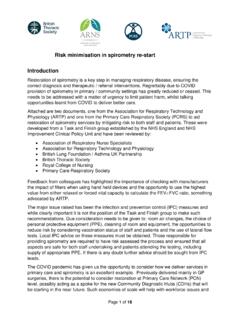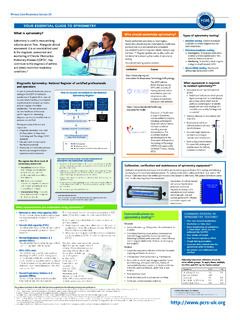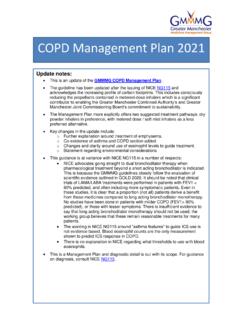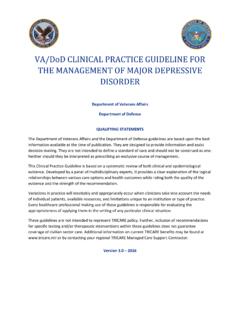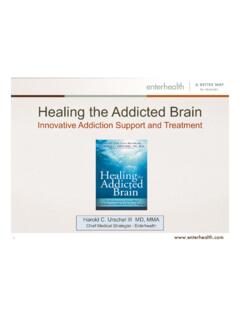Transcription of The Appropriate Use of Rescue Packs
1 Volume 5 Issue 1 SPRING 201817 Primary care RespiratoryUPDATENICE recommends prescribing Rescue Packs forpatients with COPD at risk of having an exacerba-tion, which has resulted in them becoming ,2 But are they always prescribed and usedappropriately? It is easy to prescribe a patient antibiotics andsteroids and say go away and take them when youfeel an exacerbation is coming on , says Dr JohnHurst, Honorary Consultant at the Royal Free Lon-don NHS Foundation Trust and Reader in Respira-tory Medicine at University College (UCL) this is not an effective strategy because it mayresult in misuse of the medication unless you backthe prescription up with education about how andwhen (and when not) to use the medication. A res-cue pack is more than just a prescription, it needsto be tied in to other aspects of a patient's care , Hurst, who has clinical and research interests inexacerbations of COPD, says there is insufficient ev-idence to show that Rescue Packs in themselves aresafe and cost effective at reducing hospital admis-sions.
2 However, there is Cochrane evidence toshow that self-management is associated with out-comes such as a reduction in is a big difference between effective self-man-agement and the simple prescription of a rescuepack. The problem is that, when looking at the effective-ness of Rescue Packs from a research perspective,it is more complicated than just investigating theoutcome of prescribing steroids and antibiotics tobe taken at home. This is because a Rescue packshould be linked with an educational interventionand the impact of that complex intervention, andassessing fidelity to the intervention, is more diffi-cult to assess. According to Dr Hurst, Rescue Packs are both over-and under-used. We certainly see some GPs whofeel uncomfortable prescribing them, and that is OKif you can facilitate a patient s urgent access to thepractice when they are developing an , in some ways that might be a better stan-dard of care than giving them a Rescue pack to takeat home but this is very difficult to implement formany practices.
3 Other clinicians are comfortable with givingpatients Rescue Packs on repeat prescription andensuring that the patient is well educated aboutwhen and how to use them. However, if patients donot understand the risks of overusing the medica-tion, they may run the risk of long-term complica-tions. Overuse of steroids is linked with adrenalsuppression, osteoporotic fractures, diabetes,pneumonia, psychosis, thinning skin and cataracts,and overuse of antibiotics (or not taking them forthe full course) risks antimicrobial resistance both inthe individual patient and in our society. Identifying patients who are suitable for rescuepacksSo how do you select the patients who will benefitfrom a Rescue pack? It is about recognising whichpatients are willing and able to self-diagnose andstart treatment at the start of an exacerbation.
4 Youare asking a patient to differentiate an exacerbationfrom the day-to-day ebb and flow of symptoms, andthat can be challenging for healthcare professionals,let alone those living with COPD. So this is not justabout self-management; it is also about self-diagno-sis and patients are not trained diagnosticians. Theyknow more about their own symptoms than any-body else, of course, but some people can misinter-pret their day-to-day symptom variations as anexacerbation. Dr Hurst says it is patients who are susceptible tofrequent exacerbations (at least two a year) who aremost likely to benefit from Rescue Packs . These pa-tients will know what an exacerbation feels like. There isn t any point giving a Rescue pack to a pa-tient who hasn t had an exacerbation because theywill not have experienced those symptoms before,and they will be at less risk of future events, Appropriate Use of Rescue PacksFran Robinson, discusses the use of Rescue Packs with Dr John Hurst,Honorary Consultant at the Royal Free London NHS Foundation Trust andReader in Respiratory Medicine at University College (UCL) LondonSPRING issue_Layout 1 28/03/2018 15:58 Page 19 Volume 5 Issue 1 SPRING 201818 Primary care RespiratoryUPDATEB efore considering prescribing a Rescue pack, Dr Hurst says the clini-cian must first make sure that all the high value interventions for COPD have been employed to reduce the risk and consequences of exacer-bations.
5 These include smoking cessation, influenza vaccination, pneu-mococcal vaccination, pulmonary rehabilitation and optimisation ofpharmacotherapy to ensure the patient is using the right combinationof inhalers. Then the clinician must assess whether the patient is willing and ableto take the Rescue medication as directed and has been well educatedon how and when to use it. EducationPatients need to be taught: How to recognise the start of an exacerbation (eg, whether therehas been a change in the volume, purulence or colour of thephlegm they produce normally and whether they are experiencingbreathlessness or wheeze). About the risks and benefits of the treatment Alarm symptoms things to be alert for that are not typically partof an exacerbation or things that might mean something differentis going on.
6 They must contact their healthcare professional if they have startedtheir treatment to alert them that they have become unwell As a safety net, patients should be told that, if their symptoms feeldifferent from their usual exacerbation, then taking the Rescue maynot be the right thing to do and they must also call for help fromtheir community respiratory team or GPIs it time to stop prescribing Rescue Packs in COPD?This is a question Dr Hurst will be answering in a presentation to thePCRS-UK conference in September. No is the answer, but we can andmust do it better, he says. We need to do more research into the sub-ject otherwise, if we don t address this question, we will be having thesame discussion in 10 and 20 and 30 years time. The studies are notgoing to be easy and they will be expensive, but they are needed if wewant to improve what we are currently doing, he argues.
7 One study already in the pipeline is a National Institute for HealthResearch (NIHR) Heath Technology Assessment (HTA) Programmeproposal for research into the use of sputum colour charts which couldhelp patients more accurately detect a change in their sputum symp-toms before starting a course of antibiotics. There is also promising evidence that the prescription of steroids maybe better guided by looking at blood eosinophils. Point-of- care metersmay in future be used in primary care to assess the blood eosinophilcounts of patients. This will help primary care clinicians to more accu-rately assess whether a patient will benefit from prednisolone at thetime of now, Dr Hurst says the best option for patients with COPD is toensure they have a really good self-management plan, and are empow-ered to manage their disease through attendance at a pulmonaryrehabilitation programme.
8 Those who would benefit from havingrescue Packs at home should be prescribed them with the necessaryeducational support and safety netting. References1. Chronic obstructive pulmonary disease in over 16s: diagnosis and management. NICE guideline CG101, June 2010. 2. Clinical Knowledge Summaries: Chronic obstructive pulmonary disease. NICE guideline,September 2015. 3. Self-management interventions including action plans for patients with chronic obstructivepulmonary disease (COPD). Cochrane, August 2017. points Patients who are most likely to benefit from arescue pack are those at risk of frequent exacer-bations (at least two a year) and who can recog-nise when an exacerbation is starting Before prescribing a Rescue pack:oFirst make sure all the key high-value inter-ventions for COPD have been employedto reduce the risk and consequences ofexacerbations and that the patient has a self-management planoAssess whether the patient is willing and ableto take the medication as prescribedoMake sure the patient has been educatedabout the risks and benefits of treatment andof overusing the medicationoEnsure the patient has a safety net.
9 Advisethem that, if their symptoms feel differentfrom their usual exacerbation, then takingthe Rescue may not be the right thing to doand they must also call for help from theircommunity respiratory team or GPSPRING issue_Layout 1 28/03/2018 15:58 Page 20 Volume 5 Issue 1 SPRING 201819 Primary care RespiratoryUPDATENICE recommendations1 Patients at risk of having an exacerbation of COPD should be given self-management advice that en-courages them to respond promptly to the symp-toms of an exacerbation by: Starting oral corticosteroid therapy if their in-creased breathlessness interferes with activitiesof daily living (unless contraindicated) Starting antibiotic therapy if their sputum ispurulent Adjusting their bronchodilator therapy to controltheir symptoms Patients at risk of having an exacerbation ofCOPD should be given a course of antibiotic andcorticosteroid tablets to keep at home for use aspart of a self-management strategy It is recommended that a course of corticos-teroid treatment should not last longer than 14days as there is no advantage in prolonged ther-apy The Appropriate use of these tablets should bemonitored Patients given self-management plans should beadvised to contact a healthcare professional iftheir symptoms do not improve Patients should contact a primary healthcare pro-fessional if they start treatment with a home sup-ply of medication.
10 This is to ensure thatmedications are taken appropriately; that the ex-acerbation is recorded; an attempt is made toidentify any trigger for the exacerbation; and thehome supply of Rescue medication is should be in a COPD Rescue pack? NICE2recommends that a COPD Rescue pack is partof a self-management plan to enable patients tomanage a deterioration in their symptoms (onset ofexacerbation) promptly and reduce their risk ofhospital admission. A COPD Rescue pack should include: Prednisolone 30 mg orally to be taken for 7 14days. It is recommended that a course of corti-costeroid treatment should not be longer than14 days as there is no advantage in prolongedtherapy Oral antibiotics for people with purulent sputumor clinical signs of pneumonia depending onlocal antibiotic prescribing guidelines.
